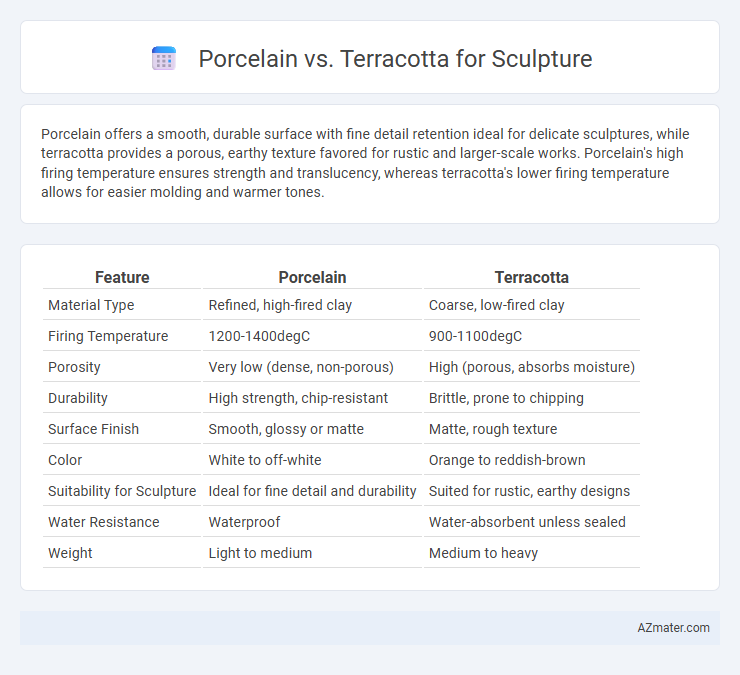Porcelain offers a smooth, durable surface with fine detail retention ideal for delicate sculptures, while terracotta provides a porous, earthy texture favored for rustic and larger-scale works. Porcelain's high firing temperature ensures strength and translucency, whereas terracotta's lower firing temperature allows for easier molding and warmer tones.
Table of Comparison
| Feature | Porcelain | Terracotta |
|---|---|---|
| Material Type | Refined, high-fired clay | Coarse, low-fired clay |
| Firing Temperature | 1200-1400degC | 900-1100degC |
| Porosity | Very low (dense, non-porous) | High (porous, absorbs moisture) |
| Durability | High strength, chip-resistant | Brittle, prone to chipping |
| Surface Finish | Smooth, glossy or matte | Matte, rough texture |
| Color | White to off-white | Orange to reddish-brown |
| Suitability for Sculpture | Ideal for fine detail and durability | Suited for rustic, earthy designs |
| Water Resistance | Waterproof | Water-absorbent unless sealed |
| Weight | Light to medium | Medium to heavy |
Introduction to Porcelain and Terracotta
Porcelain is a high-fired ceramic material known for its strength, translucency, and smooth, fine-grained texture, making it ideal for detailed and delicate sculpture work. Terracotta, a lower-fired clay, offers a porous, matte finish with a warm, earthy tone, often favored for rustic or traditional sculptural designs. Both materials possess unique qualities that influence durability, aesthetic appeal, and sculpting techniques in art creation.
Material Composition and Properties
Porcelain is a fine, white ceramic made from kaolin clay, fired at high temperatures around 1200-1400degC, resulting in a dense, non-porous, and translucent material with a smooth surface ideal for detailed sculptures. Terracotta, composed primarily of natural clay mixed with sand and iron oxide, is fired at lower temperatures between 1000-1150degC, producing a porous, reddish-brown material with a rougher texture and more brittle structure. The high vitrification of porcelain offers superior strength and water resistance, while terracotta's porous nature allows for breathability but requires sealing to prevent moisture damage.
Historical Use in Sculpture
Porcelain has been historically prized for its delicate translucency and fine detail in Asian sculpture, particularly during the Ming and Qing dynasties, while terracotta's use dates back to ancient civilizations such as the Greeks and Etruscans for its accessibility and robustness. Terracotta sculptures, exemplified by the Terracotta Army of the Qin Dynasty, showcase durability and mass production techniques, contrasting with the meticulous craftsmanship seen in porcelain figurines. Both materials reflect cultural values and technological advancements in sculpture, with terracotta favored for large, earthy forms and porcelain for intricate, refined pieces.
Aesthetic Differences
Porcelain offers a smooth, refined surface with a translucent quality that enhances intricate details, making it ideal for delicate, highly polished sculptures. Terracotta has a warm, earthy texture and matte finish, lending a rustic and organic aesthetic prominent in traditional and folk art sculptures. The color palette of porcelain tends to be cool and neutral, while terracotta's natural reddish-brown hues contribute to a grounded and tactile visual experience.
Durability and Longevity
Porcelain exhibits superior durability and longevity compared to terracotta due to its vitrified, non-porous composition that resists chipping, cracking, and moisture absorption. Terracotta, being a porous, earthenware clay, is more susceptible to weathering, erosion, and structural degradation over time, especially when exposed to outdoor conditions. Consequently, porcelain sculptures maintain their pristine appearance and structural integrity longer, making them ideal for both indoor and outdoor displays demanding lasting resilience.
Workability for Artists
Porcelain offers artists a smooth, fine texture that allows for precise detail and intricate designs, making it ideal for delicate sculpture work. Terracotta's porous, coarse nature provides better grip and ease of manipulation during the sculpting process, especially for larger, more robust forms. Workability in porcelain demands careful handling due to its fragility before firing, while terracotta's forgiving consistency supports iterative modeling and adjustments.
Firing and Finishing Processes
Porcelain sculptures require high-temperature firing, typically between 1,200degC and 1,400degC, resulting in a dense, vitrified, and translucent finish that enhances durability and intricate detail. Terracotta is fired at lower temperatures, usually around 900degC to 1,100degC, creating a porous, earthy texture that is often left unglazed or finished with matte paints and natural patinas. The finishing process for porcelain includes glazing and polishing to achieve a smooth, glossy surface, while terracotta often retains its rustic appeal with minimal surface treatment.
Cost and Accessibility
Porcelain sculptures often incur higher costs due to the material's fine quality, advanced firing process, and limited production facilities, making it less accessible for beginners or budget-conscious artists. Terracotta is more affordable and widely accessible because of its abundant raw materials, simpler preparation, and lower kiln temperatures, allowing artists to create sculptures with minimal investment. Cost-effective terracotta suits large-scale or experimental projects, while porcelain remains preferred for detailed, high-value pieces requiring precision and durability.
Ideal Applications in Sculpture
Porcelain is ideal for fine, detailed sculptures requiring a smooth, translucent finish and high durability, often used for intricate figurines and delicate works. Terracotta suits larger, more rustic sculptures due to its porous texture and earthy tones, making it perfect for outdoor garden statues and architectural elements. Artists choose porcelain for precision and refinement, while terracotta provides warmth and a natural aesthetic for expressive, larger-scale pieces.
Choosing the Right Material for Your Art
Porcelain offers a smooth, refined finish ideal for intricate, delicate sculptures requiring high detail and a translucent quality, while terracotta provides a warm, earthy texture perfect for robust, expressive forms with a natural, rustic appeal. Artists must consider porcelain's high firing temperature and fragility against terracotta's affordability, ease of use, and porous nature, which affects durability and finishing options. Selecting between porcelain and terracotta hinges on the desired aesthetic, structural requirements, and the sculpture's intended environment or display conditions.

Infographic: Porcelain vs Terracotta for Sculpture
 azmater.com
azmater.com